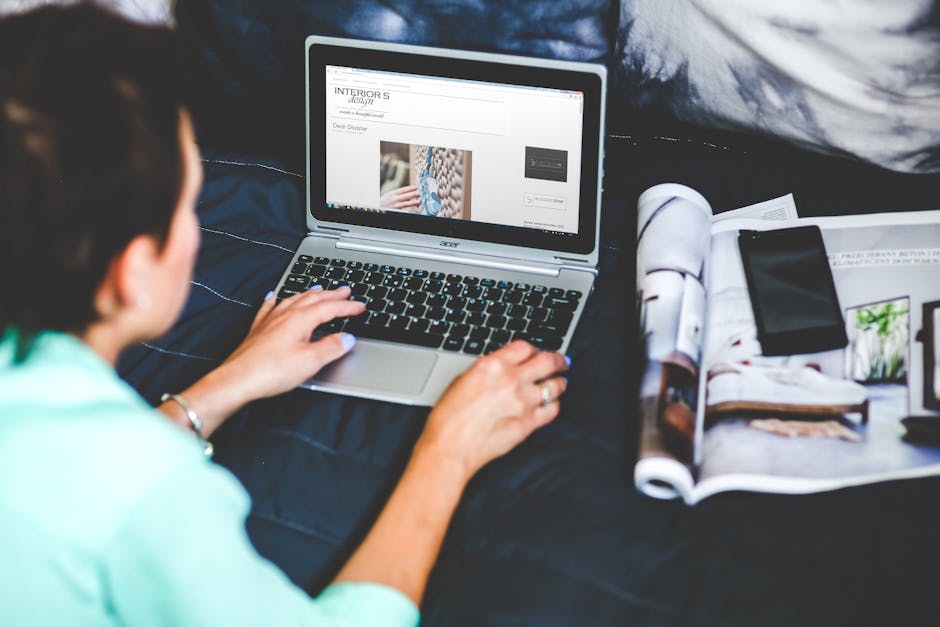
Newsletter Design Trends: How to Captivate Your Readers Right from the Start
Newsletter Design Trends: How to Captivate Your Readers Right from the Start
In today's digital communication, the design of a newsletter is crucial for success. With the ever-increasing flood of emails, newsletters need to be not only informative, but also visually appealing to grab your readers' attention. In this blog post, we'll take a look at the current trends in newsletter design and show you how to captivate your readers right from the start.
Newsletter Design: The Basis for Successful Email Marketing
In the digital age, where you receive a flood of emails every day, newsletter design is becoming a crucial factor in standing out from the crowd and grabbing the attention of your readers. The key to successful email marketing lies not only in the content, but also in the way it is presented. A well-thought-out design can make the difference between an email that is read and one that is deleted immediately.
1. Clear structure and ease of use
Your readers have little time and patience for cumbersome designs. Rely on a clear structure with logical sections. Intuitive navigation in the newsletter ensures that the most important information can be grasped quickly.
- In a nutshell: Use concise headlines and paragraphs.
- Visual hierarchy: Use typography and colors cleverly to highlight important elements.
- Adaptability: Make sure your newsletter design is responsive and looks good on different devices.
Visual Design for Emails: Colors & Typography
Colors and fonts play an essential role in email design. Not only do they have to be aesthetically pleasing, but they also have to fit the brand identity. According to a study by HubSpot, colored CTA buttons can increase click-through rates by up to 21%.
A first impression counts especially when it comes to newsletters! âÂÂ
A uniform visual appearance strengthens the branding in the newsletter design. Try a harmonious color palette and a reader-friendly font. You can find out more about the importance of colour design in our article on unusual advertising ideas.
3. Personalization as a success factor
One of the most powerful tools in email marketing is personalization. Studies show that personalized subject lines can increase open rates by 26% (source: Campaign Monitor). Use custom name or purchase history fields to customize your content.
Ultimately, it's about building a connection with the reader, a relationship that goes beyond just selling. Try different approaches and find out what resonates best with your target group.
Responsive newsletter design: mobile-optimized emails
In today⤙s world, where smartphones and tablets are ubiquitous, a responsive newsletter design is essential. According to a 2023 study by Statista, around 54% of all emails are opened on mobile devices. A responsive design ensures that your emails are optimally displayed on every device and that your message is effectively received by the reader.
Customizable layouts for all devices
A responsive newsletter layout automatically adapts to the screen size of the respective device. This means that texts remain readable and images are displayed correctly, whether your reader is using a smartphone, tablet, or desktop. For example, with an HTML newsletter, you can use flexible grids and percentage widths to ensure that your design integrates seamlessly.
- Scaling images: Use CSS techniques such as
max-width: 100%;to ensure that images do not protrude beyond the screen. - Optimize typography: Choose font sizes and line heights so that they are easy to read on smaller screens.
- Clever CTA design: Call-to-actions (CTAs) should also be easy to click on small displays – remember to keep enough distance to other elements!
The art of responsive design is to master complexity through simplicity. â â Unknown
In addition to the pure look, the charging speed also plays a decisive role. Google says that the probability of a bounce increases by 32% if a mobile page takes longer than three seconds, so optimize your images and use the latest technology such as the WebP image format (more on this in our Blog post about WebP ) for faster loading times.
Simple testing methods for your mobile designs
Before you send your email campaign, test the layout on different devices and mail clients using tools like Litmus or Email on Acid. A/B testing helps you figure out which version of your newsletter resonates best.
Whether it's fun creativity or functional clarity, with a mobile-optimized design, you'll make sure your readers are engaged from the start. Remember, a good first impression can be the difference between a successful interaction or quickly deleting your message.
Creative newsletter ideas: Innovative and appealing design
In today's digital era, it's essential to stand out from the crowd with creative ideas, especially when it comes to newsletters. An innovative and appealing design can make the difference between a skimmed newsletter and an intensively read newsletter.
Use visuals in a targeted manner
- Pictures: High-quality images are not only eye-catchers, but also convey emotions. However, they should be well compressed to minimize loading time.
- Icons: Small graphics can help to convey information quickly and break up the text.
- Colours: A well-thought-out colour scheme in the newsletter creates recognition and can strengthen the brand identity. According to a study by HubSpot, colors can increase brand recognition by up to 80%.
Interactive elements for more engagement
Interactivity can encourage your readers to engage with the content more deeply:
- Clickable image galleries: These allow readers to discover more details without having to leave the newsletter.
- Quick polls: Short interactive surveys or quizzes engage readers and provide valuable feedback.
- GIFs: Moving images attract attention and can simply present complex issues.
The goal of a newsletter should be not only to be informed, but also to be inspired. â – Anonymous Wisdom
Practical tip: Personalization as a key
Nothing speaks to a reader more than a personalized approach. Studies have shown that personalized emails have a 29% higher open rate (source: Campaign Monitor). Therefore, use all available data points to present individual content.
Would you like to learn more about creative ideas in digital communication? Then visit our blog article about overcoming creative blocks: Why less pressure is the key to success.
Create personalized newsletters: Individually address your target group
In digital communication, personalization is not just a trend, it's a necessity. Studies show that personalized newsletters achieve up to 29% higher open rates than generic emails (source). This underlines the importance of an individual approach as a key element of successful email campaigns.
Benefits of personalization
- Increase customer loyalty: By addressing your readers by name and responding to their preferences, you create a more personal connection.
- Improved conversion rates: Personalized call-to-actions (CTAs) can significantly increase the click-through rate.
- Better data analysis: By collecting data on user preferences, you can make future campaigns more targeted.
Tips for implementation
In order to successfully implement personalized newsletters, you should consider the following aspects:
- Collect and structure data: Use sign-up forms and user profiles to capture relevant information.
- Use dynamic content: Integrate elements such as variable text modules or target group-specific offers into your newsletter layout.
- Perform A/B testing: Test different personalization strategies to see which ones work best for your audience.
The future of email marketing belongs to those who know how to engage their readers on a personal level. â â Unknown
Would you like to learn more about how Promotional Office March can help you implement creative newsletter ideas? Take a look at our extraordinary advertising ideas in the field of marketing: Services of the advertising office March .
Whether it's through the use of images or creative design prototypes for newsletters, a personal touch in your emails makes all the difference. So rely on creative strategies and stand out from the competition!
Visual Communication in Newsletters: Typography and Color Design
In the digital world we live in, visual communication in newsletters is crucial to stand out from the crowd. Well thought-out typography and color design can make all the difference here. Let's take a closer look at these aspects.
Typography: More than just beautiful letters
Choosing the right font not only affects readability, but also contributes significantly to brand identity. According to a study by Adobe, 73% of respondents prefer content with good design and appealing typography. Therefore, consider the following tips:
- Clarity before complexity: Use clear and simple fonts like Arial or Helvetica to maximize readability.
- Maintain consistency: Use consistent typography for headlines and flowing text to create a harmonious overall look.
- Size counts: Make sure that the font size is easy to read on both desktop and mobile devices.
Colour design: The right tone makes the music
Colors are powerful tools in digital communication. They can arouse emotions and influence actions. In fact, a study by Kissmetrics shows that colours can account for up to 85% of the reason someone buys a product. Here are some color choice considerations:
- Focus on brand colors: Take advantage of your already established brand colors to increase recognition.
- Combination is key: Use high-contrast colors for text and background to highlight important information.
- Psycho Colors: Blue, for example, promotes trust and peace of mind, ideal for newsletters in the financial sector.
âÂÂDesign is the silent ambassador of your brand. â â Paul Rand
Last but not least, the design of your newsletter should of course be responsive. A well-designed email layout adapts to the different devices and thus ensures an optimal user experience at all times. Take a look at our Marketing and Advertising Services at Werbeböro March for further innovative approaches in the design of your newsletter.
UX in newsletter design: Increasing user-friendliness
In digital communication, one thing counts above all: an outstanding user experience (UX). Especially in the field of newsletter design, a well-thought-out UX can make the difference between an opened and a directly deleted newsletter. But how can user-friendliness be taken to a new level?
1. First impressions count: Clarity and structure
A clearly structured newsletter layout is crucial for the user experience. Readers should be able to see immediately what the newsletter is about. Use clear headings and logical paragraphs to keep the content clear.
- Short paragraphs: Long blocks of text have a deterrent effect. Keep your paragraphs short and concise.
- Clear call-to-actions (CTA): Place your CTAs so they can't be overlooked.
- Visual design for emails: Use images sparingly and make sure they don't interfere with readability.
2. Mobile optimization is mandatory
According to a study by Litmus, 46% of all emails are opened on mobile devices. This makes a responsive newsletter design indispensable. Make sure your design displays optimally on all types of devices, whether it's a smartphone or tablet.
¢ e-mails that are not mobile-optimized lead to 75% fewer interactions.â¢Ââ
3. Personalization increases retention
Nothing speaks more for a successful UX than a personalized newsletter. Use data from your email marketing to tailor content to individual preferences. This can significantly increase the opening rate.
Note: You may be wondering: "What about privacy? Don't worry! Responsible handling of data is the be-all and end-all in modern communication.
4. Test, test and test again!
Nothing is worse than a faulty layout or broken links in the newsletter. Use tools like Litmus or Email on Acid to put your design through its paces and make sure everything works smoothly.
Make UX a priority in newsletter design and watch how your engagement increases ¢¢â your readers will thank you!
To sum up, modern newsletter design should not only be aesthetically pleasing, but also functional and purposeful. By using these trends, you can ensure that your message stands out in a crowded digital landscape and that your readers are engaged from the start.

